On View
At 91, Painter Sally Cook Has Finally Shed Her Outsider Status. Why Did the Art World Take This Long to Embrace Her?
A survey of Cook’s career is on view now at Eric Firestone Gallery in New York.
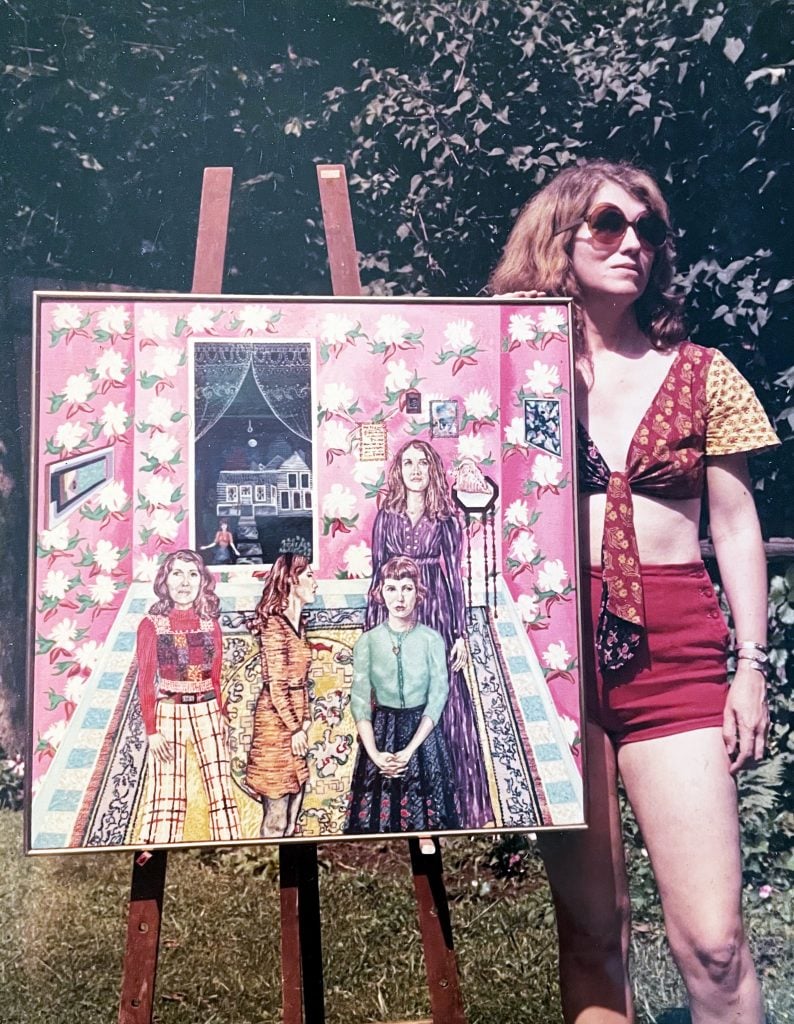
A survey of Cook’s career is on view now at Eric Firestone Gallery in New York.

Taylor Dafoe

In Sally Cook’s 1975 canvas Self Portrait Five Images, the painter and poet depicts herself in different decades of her life—one in the then-present, and two each in the past and future. The youngest version of the artist is the only one not shown standing inside her mother’s parlor; she is, instead, framed through a window: literally on the outside looking in.
“She’s the artist,” Cook, now 91, recently said of her younger painted self. “She’ll never get in.”
For a long time, that’s how Cook viewed herself in relationship to the art world: an outsider. She felt that way in the 1950s, as a woman trying to carve out a place for herself in New York’s male-dominated 10th Street scene, and again after moving back to her hometown of Buffalo, New York in the 1960s, when the city’s insular arts institutions disregarded her charming, domestic figuration as craft.
“I was treated like a non-person,” she said, chip still on her shoulder.
Self Portrait Five Images is one of several standouts in “Where Fantasy Has Bloomed, Painting and Poetry since the 1960s,” an excellent survey of Cook’s work on now through July 8 at Eric Firestone Gallery in New York. Included is work from three decades of her career—a time period that saw her switch styles, cities, and priorities. It expands on an exhibition that opened at the University of Buffalo Art Galleries in mid-March of 2020, only to be shuttered by the COVID-19 pandemic days later.
For Cook, who has not been the beneficiary of many breaks, the abrupt closure of the 2020 exhibition must have arrived like a devastating quietus to her career. But now, thanks to independent curator Julie Reiter Greene, who organized the current show, Cook finally got the victory lap she long deserved. “I hope it helps cement her legacy,” Greene said.
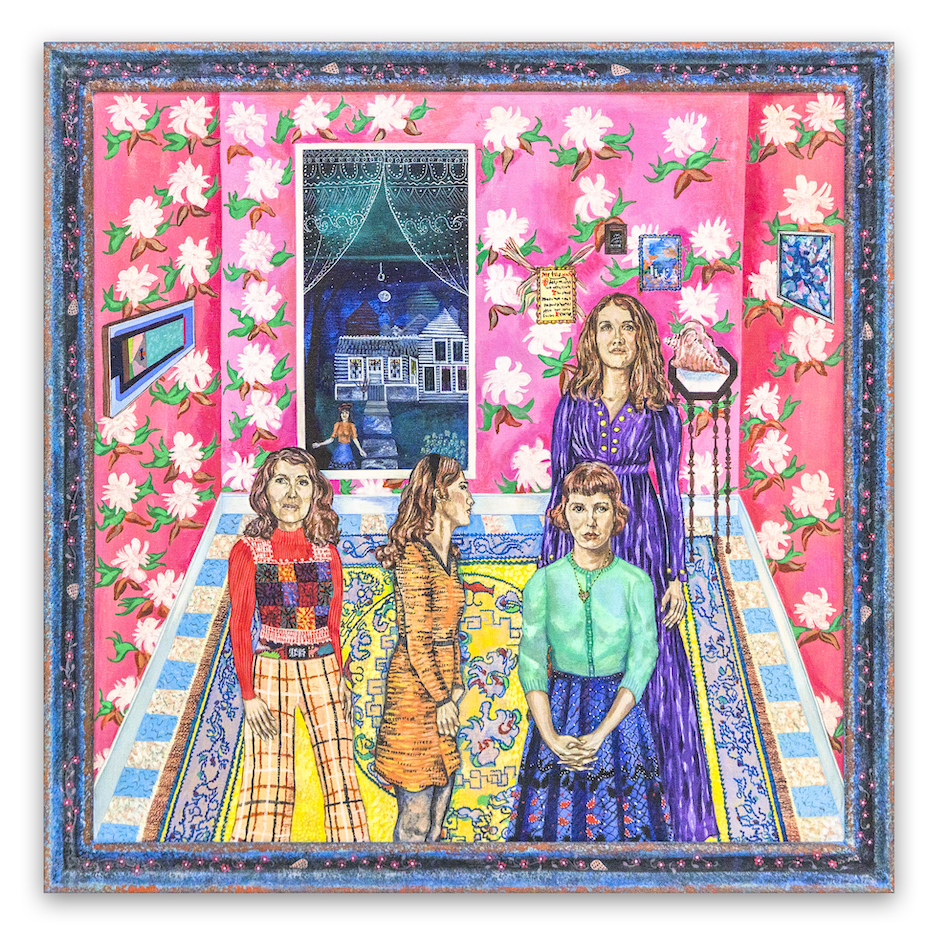
Sally Cook, Self Portrait Five Images (1975). Courtesy of the artist and Eric Firestone Gallery.
The last time Cook showed in New York, she was living there, renting a room on the Bowery and frequenting the Cedar Tavern and The Club, where art stars like Franz Kline and Willem de Kooning held court. Cook shared these artists’ interest in pushing the limits of abstraction, but not their egos or ambitions.
“I was interested in abstract expressionism as an idea, but the thing is, nobody wanted to talk about it! They just wanted to move as quickly as possible from 10th Street to 57th Street,” she said, referring to the group of old-guard, commercial galleries that gathered uptown.
After a pair of group shows, Cook had her first solo exhibition at Phoenix Gallery on 10th Street in 1959, then a second one there in 1961. Two abstract canvases from the latter exhibition are on view now at Eric Firestone: Opalescence and Liver of the Roses, both completed in 1960. They recall the floral palette and emotive gesturalism of Joan Mitchell, albeit with a density of composition that Mitchell didn’t embrace until later in her career. Cook, for her part, never left an inch of canvas unfilled.

Sally Cook, Opalescence (1960). Courtesy of the artist and Eric Firestone Gallery.
That wasn’t always a popular choice. She said it was these same stylistic flourishes that, back in the 1950s and 60s, irked her contemporaries—particularly those indoctrinated by the de rigueur formalism of Clement Greenberg and Harold Rosenberg. “Why do you paint to the edge of the canvas? Why do you use so much color?” she recalled contemporaries asking of her work, her voice inflected with an imitative paternalism.
“Sally felt that there were rules in place—very dogmatic rules—that she had to follow, and that there wasn’t room for discussion on how to push those boundaries,” Greene explained, noting that Cook has “always been somebody who questions limitations and boundaries.”
After a third solo effort at Camino Gallery—another 10th Street fixture—Cook decamped from Manhattan to Buffalo. “I learned a lot,” she said of her New York experience, “enough to know that I wanted to leave.”
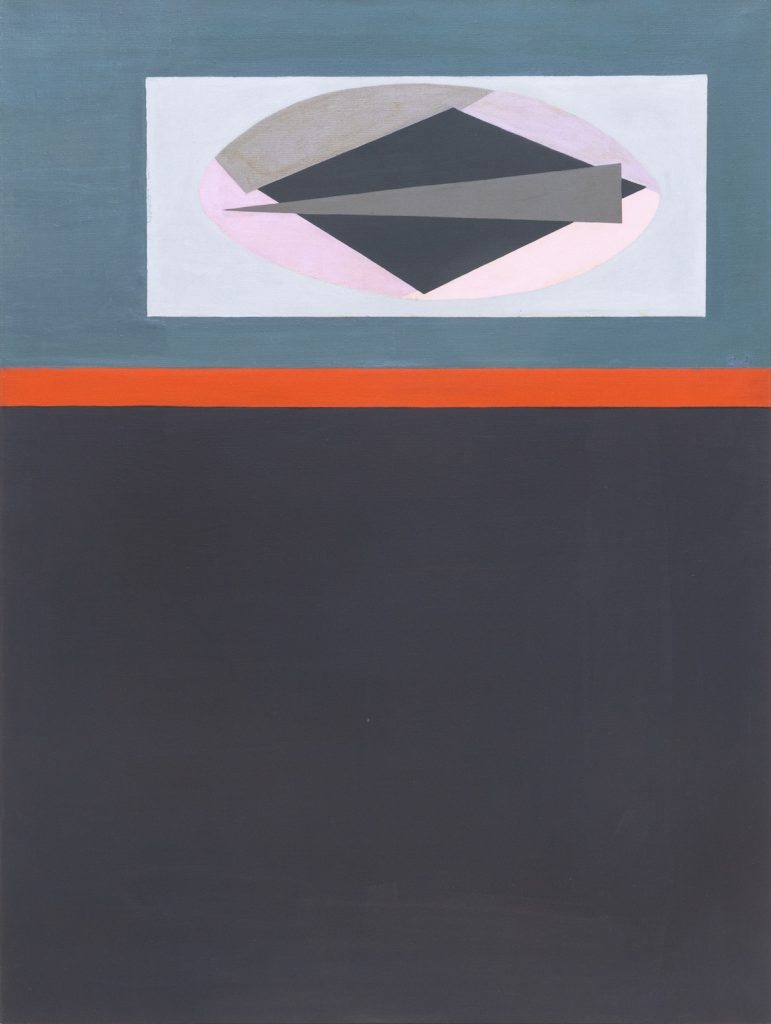
Sally Cook, The Bird Who Died From Sleeping Too Much (1967). Courtesy of the artist and Eric Firestone Gallery.
Back home, the artist’s work grew cleaner and tighter, evolving into hard-edged geometric abstractions. Graphic blocks of color filled her canvases, but even then you could see her fondness for figuration starting to peak through. Take The Bird Who Died From Sleeping Too Much (1967), also included in “Where Fantasy Has Bloomed.”
Based on a recurring dream related by a friend, the painting features stacked gray triangles at its top—a blackbird deconstructed into shapes. Below it is a band of red paint—a “thin line of rage,” Cook called it. The painting is, in both color and tone, one of the artist’s darker works.
By the early 1970s, figuration fully entered Cook’s practice; so did a newfound sense of humor and intimacy. She began painting pets and friends and members of the Buffalo art scene, often situating her subjects in funky clothes amidst a rich tableau of personal effects: favorite furniture, books, rugs, art. Much like the theatrical paintings of Florine Stettheimer (who was also a poet), Cook’s portraits double as studies of class codes and social etiquette
Cook also embraced her own avowed struggles with perspective, flattening her scenes to emphasize their uncanniness. In a commissioned 1970 portrait of collector Charles Penney, founder of Buffalo’s Burchfield Penney Art Center, the subject towers over his prized possessions, including Josef Albers, Alexander Calder, and Robert Goodnough. (Here again, Cook paints herself standing outside, framed through a window in Penney’s house.)
“The flatness is, for me, like a wolf in sheep’s clothing,” said Greene. “There’s an intentional deception and cheekiness. It’s tied to her play between surface and depth. You think you see everything about her work on the surface… and yet, there are so many layers and references and this absurdity and uncanniness to the way in which she’s capturing human experience.”
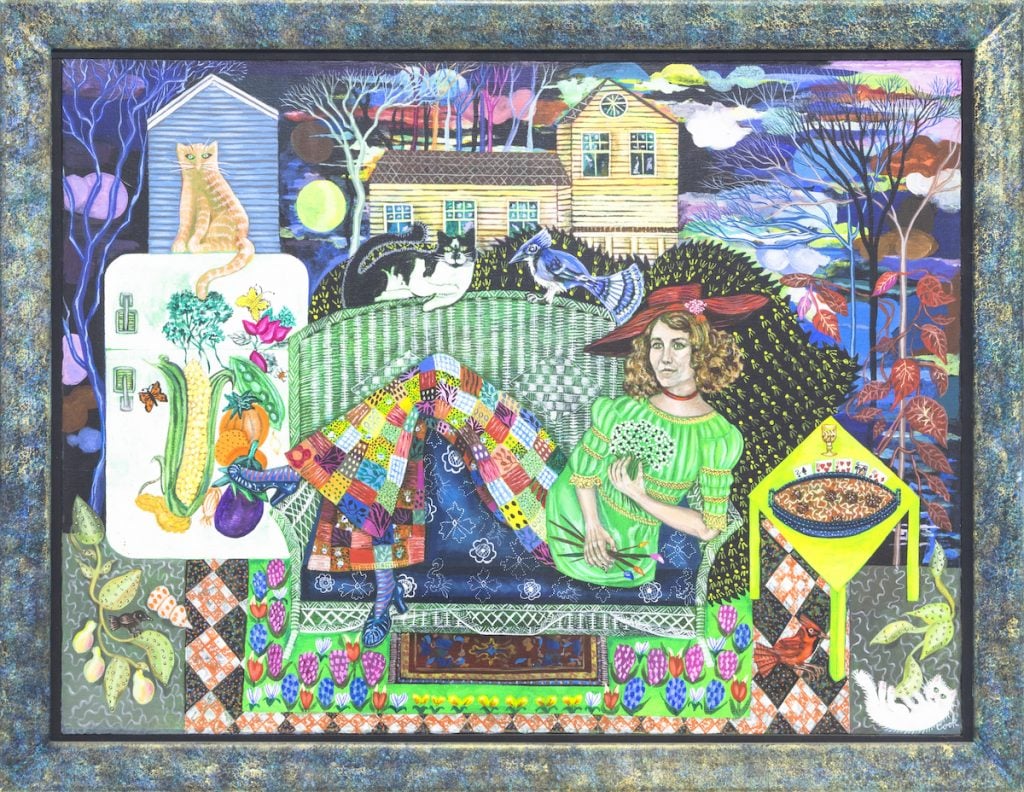
Sally Cook, Gypsy At The Carnival of Life (1976). Courtesy of the artist and Eric Firestone Gallery.
Cook’s efforts from this period seemingly shared little in common with her geometric experiments of the preceding years, let alone the all-over abstractions from her time in New York. Whereas those earlier artworks had only a distant, symbolic relationship to the world, her representational paintings felt almost defiantly idiosyncratic, the work of an artist whose search for meaning led her through the looking glass—and the gatekept enclaves of the capital A art world—back to her own life.
She began to center herself in the frame—often literally, in the form of self-portraits, but sometimes slyly too, through symbols encoded with personal meaning. Occasionally, she even included depictions of older paintings in new ones. That’s the case with her 1983 painting God Gave a Crow a Piece of Cheese; He Turned Around and Gave Me These. Named after a Chekhov story, it features Cook surrounded by examples of past work, many painted from memory.
“I stuffed into my painting as many of my works as I could recall,” Cook said in a story recounted by Greene. “While their colors and shapes jostle and create a community, I am alone. No one has ever given me any cheese. A bit of cheese can no doubt satisfy a crow, but this crow knows better than to depend on it.”
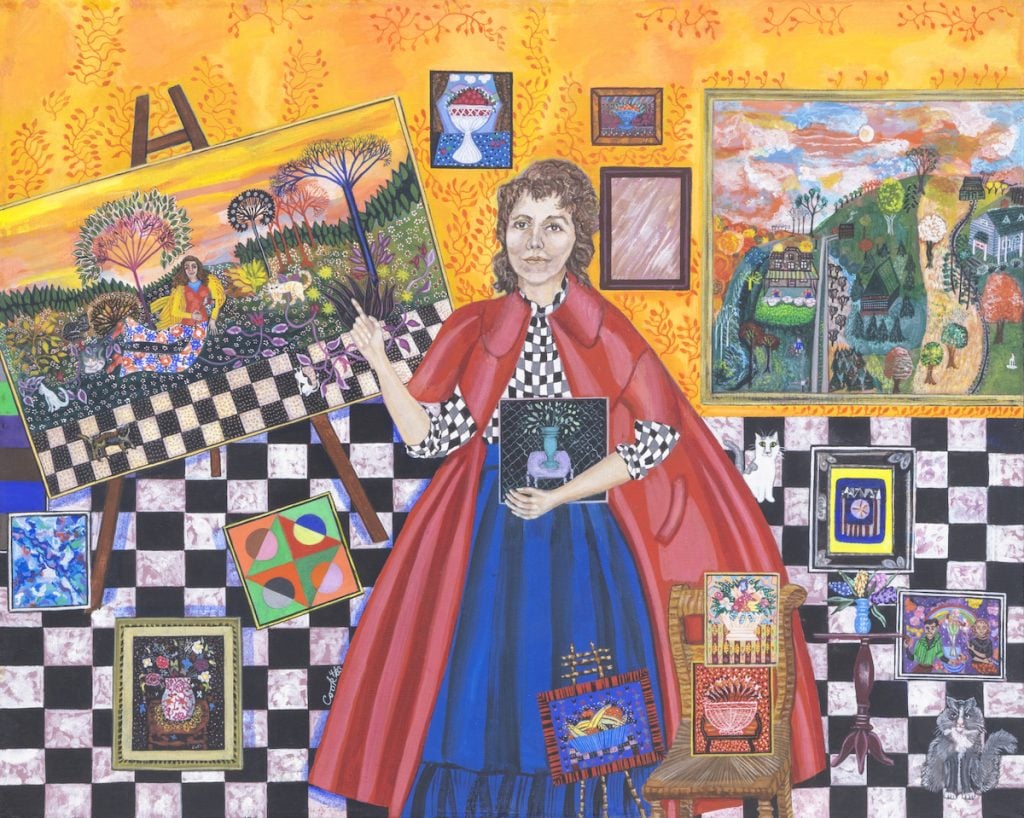
Sally Cook, God Gave a Crow a Piece of Cheese; He Turned Around and Gave Me These (1983). Courtesy of the artist and Eric Firestone Gallery.
“Sometimes she’ll depict herself, sometimes she’ll depict her paintings, but it’s all her,” explained Greene. “I think it was about legacy and the canon and wondering if her work would end up in museums, or if she would just need to keep presenting her own work, keep painting it back in to say, ‘Look at what I’ve been producing.'”
Cook pulled the same trick with Self Portrait Five Images, where early her abstractions Blue Green Forever (1960) and A Flag for Delores IV (1965) are shown hanging on the Pepto Bismol-pink walls next to the various versions of herself. (Those same paintings flank Five Images at Eric Firestone too—a clever installation trick from Greene.)
Though Cook may sympathize with the younger image of herself in that painting, it’s the oldest one she most resembles now—and not just because of age. With her hands at her sides and eyes fixed on the viewer, the elder figure is firmly—finally—on the inside.
When asked if she feels that way now, with a survey of her life’s work on view in the city where it started, Cook simply said, “Yes,” then paused. “Thank God I lived long enough to see it!” she added, only half joking.
“Sally Cook: Where Fantasy Has Bloomed, Painting and Poetry since the 1960s” is on view now through July 8 at Eric Firestone Gallery in New York.
More Trending Stories:
The Venice Biennale Has Announced the Highly Anticipated Curatorial Theme of Its 2024 Art Exhibition
A Couple Renovating Their Kitchen in Denmark Found an Ancient Stone Carved With Viking Runes